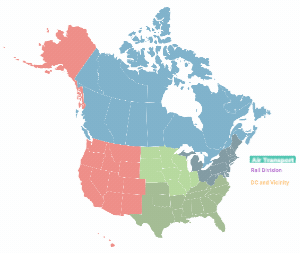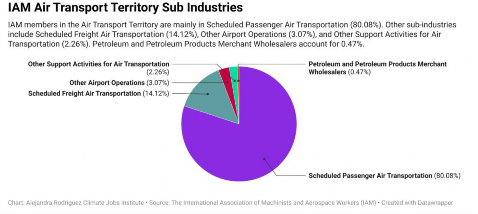The IAM Air Transport Territory
 The IAM Air Transport Territory represents over 60,000 workers, including mechanics, customer service representatives, ramp workers, flight attendants, security agents and Network Operations Control agents for commercial and freight travel. These members are spread across 25 states, with Illinois making up over 40% of the Territory’s workforce. Just five states–Illinois, Texas, Washington, Hawaii, and California–account for over 75% of the territory’s membership.122 Major employers in the industry include United Airlines, Southwest Airlines, American Airlines, Hawaiian Airlines, Spirit Airlines, Alaska Airlines, and Swissport.123 A small percentage of the IAM Air Transport members work in wholesale distribution of petroleum and petroleum products, which are essential for fueling and maintaining aircraft.124
The IAM Air Transport Territory represents over 60,000 workers, including mechanics, customer service representatives, ramp workers, flight attendants, security agents and Network Operations Control agents for commercial and freight travel. These members are spread across 25 states, with Illinois making up over 40% of the Territory’s workforce. Just five states–Illinois, Texas, Washington, Hawaii, and California–account for over 75% of the territory’s membership.122 Major employers in the industry include United Airlines, Southwest Airlines, American Airlines, Hawaiian Airlines, Spirit Airlines, Alaska Airlines, and Swissport.123 A small percentage of the IAM Air Transport members work in wholesale distribution of petroleum and petroleum products, which are essential for fueling and maintaining aircraft.124

The aviation sector is a major carbon emitter, and it is also vulnerable to the effects of climate change. Record heat affects aircraft performance, reducing plane carrying capacity, and even grounding flights.125 Frequent and severe extreme weather events, like floods, hurricanes, tornados, rising seas and more, damage essential infrastructure, ground flights, and increase hazards at airports.126 “Climate change has impacted the industry on the whole,” says Air Transport Territory Chief of Staff Edison Fraser, “whether it’s the members or the passengers or the airlines”.127 Left unaddressed, extreme weather will continue to upend working conditions and threaten the air transport industry itself.
IAM members in the industry face increasing on-the-job risks linked to climate change. A 2021 report from the European Transit Union Institute identified several heat-related risks to workers,
![]()
122 International Association of Machinists and Aerospace Workers, “Air Transport and Rail Membership Revised,” June 27, 2024.
123 International Association of Machinists and Aerospace Workers.
124 U.S. Bureau of Labor Statistics, “Industries at a Glance.”
125 Salerno, “Can It Be Too Hot for a Plane to Fly? How the Phoenix Airport Is Handling Record Heat.”
126 Williams, “Climate Change Is Disrupting Air Travel.”
127 Fraser, interview.
including heat stroke, cramps, exhaustion, organ failure, and fever.128 People laboring under heat stress are more likely to suffer accidents and injure themselves or others, and prolonged exposure to extreme heat and UV also increases the risk of chronic eye and organ illnesses.129 This also raises equity concerns, as large percentages of airport service workers in the United States are immigrants and people of color.130
Working in primarily non-climate controlled facilities – such as on tarmacs or in trucks – poses its own health issues.131 “Most of those workers are black and brown, and man, are they suffering,” reports Human Rights Director Nicole Fears. “They are subjected to heat that we know is unhealthy. 100 degrees doesn’t feel like 100 degrees anymore.”132 According to IAM Director of Safety and Health Michael Oathout, workers often interpret heat stress as common illnesses, and go to their doctor, who may not account for or fully understand workplace hazards.133 The best way to ensure safe working conditions is to address new hazards before they arise.
As airlines scramble to deal with climate-caused disruptions, working conditions in the industry are deteriorating. The FAA reports that weather is responsible for more than 75% of flight delays–and weather patterns are becoming more difficult to predict.134 Customer service workers shoulder the burden of delays, prolonged flights, reroutes, and last-minute cancellations by managing angry travelers and assisting those in difficult situations.135 Extended travel times mean longer hours on the job, and employers often push mandatory overtime to cover for unexpected disruptions.136 Leaders in the Air Transport Division have negotiated increased compensation and limits to mandatory overtime, and such efforts are likely to continue as weather emergencies take a larger toll on the industry.
Rising heat has been an important issue in the campaign at Delta Airlines, where the IAM is organizing ramp, cargo, and tower workers. For example, many Delta workers are required to wear “bump caps” to reduce the risk of head injury. However, in many classifications, the caps serve no obvious safety purpose and create new hazards by trapping heat. According to Oathout, Delta workers have recorded temperatures under the caps to be 20–30 degrees above outdoor temperatures.137
![]()
128 Narocki, “Heatwaves as an Occupational Hazard The Impact of Heat and Heatwaves on Workers’ Health, Safety and Wellbeing and on Social Inequalities.”
129 Narocki.
130 García, “Rep. García, Sen. Markey, Reintroduce Good Jobs for Good Airports Act to Ensure Airport Service Workers Earn Living Wage, Benefits.”
131 Narocki, “Heatwaves as an Occupational Hazard The Impact of Heat and Heatwaves on Workers’ Health, Safety and Wellbeing and on Social Inequalities.”
132 Fears, interview.
133 Oathout, interview.
134 Oathout.
135 Fraser, interview.
136 Fraser.
137 Oathout, interview.
The Delta Organizing Campaign & Bump Caps
Delta is the only U.S.-based mainline carrier where a union does not represent flight attendants, fleet service, and mechanics. As a result, tens of thousands of Delta workers lack a voice on the job. As part of a multi-union campaign, the IAM is currently organizing approximately 20,000 ramp, cargo, and tower workers.138
Gameli Appiah is a ramp worker and union organizer at Atlanta International Airport. Having previously worked at UPS, Appiah understands the union difference. “I was surprised when I came to Delta to see the shape the equipment was in. It’s a lot of equipment that shouldn’t be out there. It’s dangerous.”139
IAM member-led safety committees help implement informed safety procedures. At Delta, policies come down from executives with their eyes on the bottom line. Workers face disciplinary action if they don’t wear a “bump cap,” supposedly to reduce head injuries. The caps–which often serve no obvious safety purpose–can raise temperatures 20–30 degrees for the person wearing it. “Climate justice is affecting workers, and in most cases, it’s always going to hit the folks on the bottom,”140 says Human Rights Director Nicole Fears. “If you’re outside, you’re definitely suffering.”141 What’s more, Delta only provides seven days off for sickness and personal leave, often forcing sick workers to choose between their health and their families’ needs.
“Nobody should be getting ill or dying from heat related illnesses,” argues Appiah, “We can prevent [tragedy] with basic safety measures, proper staffing, and education, instead of being so focused on profit that somebody doesn’t make it home to their family.”142 The climate crisis heightens the need for workers to have a voice on the job. The Delta campaign demonstrates why climate adaptation must be a core part of new organizing campaigns.
END PULL-OUT BOX
At IAM-represented worksites, safety committee members walk the shop and collect data that informs safety procedures and bargaining priorities.143 When hazards arise, union officers and representatives can draw from up-to-date information to craft recommendations or demands. “The union difference” says Fraser, “is that we have established safety procedures…If it’s brought to our attention by the workers, we address those issues with the company.”144
![]()
138 International Association of Machinists and Aerospace Workers, “Delta Workers, Labor, and Community Allies Hold Powerful Discussion with Roland Martin in Atlanta.”
139 Appiah, interview.
140 Appiah.
141 Appiah.
142 Appiah.
143 Fraser, interview.
144 Fraser.
In addition to threatening workers, extreme weather threatens the future of air travel. In May 2024, extreme turbulence rocked a Singapore Airlines flight. High winds threw passengers and crew members throughout the cabin. Pilots steered the flight to an emergency landing, but dozens of passengers sustained injuries–and one lost his life.145 Lightning storms and high winds all disrupt air travel by damaging planes, delaying flights, and endangering people on the ground.146
Sea level rise, a direct consequence of the warming climate, already threatens hundreds of coastal airports around the world.147 In 2012, flooding from Hurricane Sandy shut down New York’s LaGuardia Airport for three days.148 Major worksites, such as Newark Airport, are at risk of inundation if global temperatures continue to rise.149 Violent storms, wildfires, and floods have endangered IAM members at airports in Puerto Rico, Guam, and Hawaii.150 Disruptive and dangerous weather events are making aviation jobs more hazardous and precarious.
Aircraft emissions, including CO2, nitrogen oxides, and particulates, have a substantial warming effect on the climate.151 A shift toward more sustainable aviation practices that centers workers’ perspectives will improve lives and the industry’s long-term outlook. Workers on the frontlines can help lead the way. Fraser sees transparent long term planning as a win-win proposition: “The public would recognize an airline that comes out and says, ‘we’ve met with our unions, we’re going to [decarbonize] in a way that doesn’t affect work.’”152
